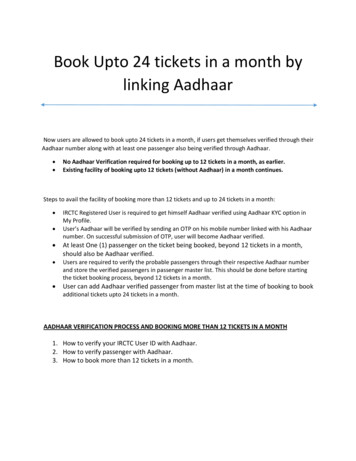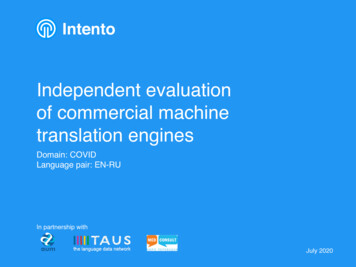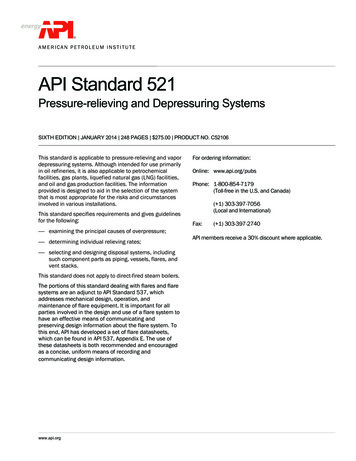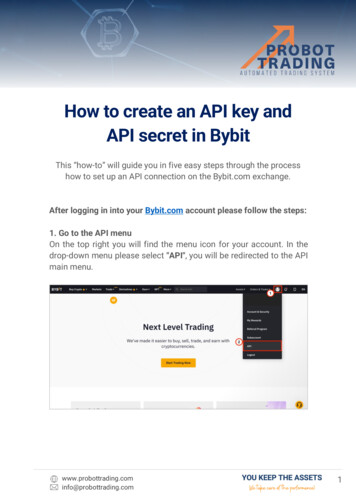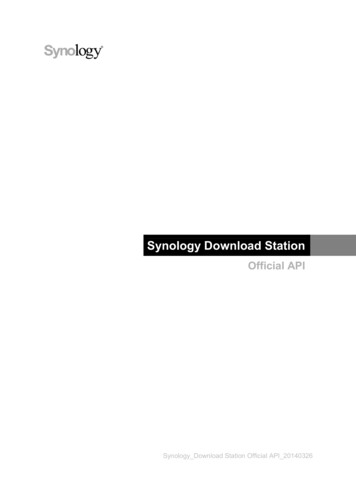
Transcription
Unique Identification Authority of India (UIDAI)Government of India (GoI)Bangla Sahib Road, Behind Kali Mandir, Gole MarketNew Delhi 110001AADHAAR E-KYCAPI SPECIFICATION - VERSION 2.5AUGUST 2019
Version 2.5Aadhaar e-KYC APITable of Contents1.INTRODUCTION . 31.11.21.31.42.UNDERSTANDING AADHAAR E-KYC SERVICE . 52.12.22.32.43.ELIMINATING PHOTO COPIES AND COSTLY, INSECURE PAPERWORK . 5LIMITED E-KYC . 5AADHAAR E-KYC API USAGE . 6CONCLUSION . 6AADHAAR E-KYC API . 73.13.2E-KYC API DATA FLOW . 7API PROTOCOL . 83.3E-KYC API: INPUT DATA FORMAT. 93.4E-KYC API: RESPONSE DATA FORMAT . 103.2.13.3.13.4.14.TARGET AUDIENCE AND PRE-REQUISITES . 3TERMINOLOGY . 3LEGAL FRAMEWORK . 4OBJECTIVE OF THIS DOCUMENT. 4Element Details . 8Element Details . 9Element Details . 12APPENDIX . 164.1CHANGES IN VERSION 2.5 FROM VERSION 2.1 . 16 UIDAI, 2011-2018http://uidai.gov.in/Page 2 of 16
Version 2.51.Aadhaar e-KYC APIIntroductionThe Unique Identification Authority of India (UIDAI) has been established with themandate of providing a Unique Identification Number (Aadhaar) to all residents ofIndia. The UIDAI also provides the service of online authentication of identity on thebasis of demographic and biometric data.Verification of the Proof of Identity (PoI) and Proof of Address (PoA) is a keyrequirement for access to financial products (payment products, bank accounts,insurance products, market products, etc.), SIM cards for mobile telephony, and accessto various Central, State, and Local Government services. Today, customers providephysical PoI and PoA documents. Aadhaar is already a valid PoI and PoA document forvarious services in the Financial, Telecom, and Government domains. In addition, theUIDAI now also proposes to provide an e-KYC service, through which the KYC processcan be performed electronically. As part of the e-KYC process, the resident authorizesUIDAI (through Aadhaar authentication) to provide their basic demographic data forPoI and PoA along with their photograph (digitally signed) to service providers.Service providers can provide a paperless KYC experience by using this API and avoidthe cost of repeated KYC, the cost of paper handling and storage, and the risk of forgeddocuments.1.1Target Audience and Pre-RequisitesThis is a technical document that is targeted at software professionals who areincorporating the Aadhaar e-KYC API into their applications.Readers should also read the following related documents for complete understanding.1. Aadhaar Authentication API http://uidai.gov.in/images/resource/aadhaar authentication api 2 5.pdf2. Aadhaar Registered Devices Specification https://uidai.gov.in/images/resource/Aadhaar Registered Devices 2 0 4.pdf3. Aadhaar Request OTP API http://uidai.gov.in/images/resource/aadhaar otp request api 2 5.pdf1.2TerminologyReaders are expected to be familiar with the general terminology used in Aadhaarauthentication such as AUA, ASA, etc. before reading this section.KYC User Agency (KUA): KUAs are AUAs that are eligible for the e-KYC service. UIDAI, 2011-2018http://uidai.gov.in/Page 3 of 16
Version 2.5Aadhaar e-KYC APINote: All further references to AUA in the rest of this document automatically refer toKUA. From a contract perspective, only KUA needs to have a contract with UIDAI.1.3Legal FrameworkThe Aadhaar (Targeted Delivery of Financial and Other Subsidies, Benefits and Services)Act 2016 was published in gazette notification on March 26, 2016. The Act is to providefor, as a good governance, efficient, transparent, and targeted delivery of subsidies,benefits and services to Aadhaar number holders. A gazette notification was issued byCentral Government on 12th July 2016 to establish UIDAI as an Authority andoperationalize certain provisions of Aadhaar Act 2016. Authentication regulations arealso published under this Act. These documents specify legal framework forauthentication usage, AUA/ASA engagements, audits, and other details. Detailed tml.1.4Objective of this documentThis document provides Aadhaar e-KYC API technical specifications. It contains detailsincluding API data format, protocol, and security specifications. UIDAI, 2011-2018http://uidai.gov.in/Page 4 of 16
Version 2.52.Aadhaar e-KYC APIUnderstanding Aadhaar e-KYC serviceThis chapter describes Aadhaar e-KYC API, its background, and usage. Technical detailsrelated to the API are provided in subsequent chapters.2.1Eliminating Photo copies and Costly, Insecure PaperworkAadhaar is now a valid Proof of ID (PoI) and proof of Address (PoA) for most services isfast being the key document for banking, telco, insurance, Government subsidyprograms, Passport, PAN card, etc. Considering the large number of Aadhaar numberholders in India and the ability to uniquely authenticate all Aadhaar number holders,more and more services are accepting Aadhaar for their service delivery.Traditionally all “Know Your Customer (KYC)” processes and verification of PoI and PoAare done using copies of PoI/PoA documents. It is commonplace to provide self-attestedphotocopies of these documents every time a bank account is opened, SIM card issued,insurance is purchased, etc.Aadhaar e-KYC service eliminates the need for the resident to provide photo copy ofAadhaar letter and instead resident can simply authenticate and authorize UIDAI toshare the Aadhaar letter data in electronic and secure (encrypted and digitally signed)fashion instead of leaving paper copies of the identity document everywhere.Eliminating paper verification and storage removes fraud, fake document usage, paperstorage cost, manual audit cost, etc. and makes entire process seamless, auditable, andsecure. And most importantly this allows services such as bank account opening etc.done using a mobile handheld in rural environments without worrying about theauthenticity of papers and trustworthiness of front end touch points.2.2Limited e-KYCThis allows agencies to do paperless KYC process without access to Aadhaar numberthus significantly enhancing the privacy within Aadhaar system.UIDAI will categorize all AUAs into two categories – “Global AUAs” and “Local AUAs”.Once this scheme is fully implemented, ONLY Global AUAs will have access to e-KYCwith Aadhaar number, while all other agencies will only have access to “Limited KYCwith masked Aadhaar Number”.a. Global AUAs: UIDAI from time to time will evaluate AUAs based on the lawsgoverning them and categorize them as “Global AUAs”. Only such agencies willhave access to Full e-KYC (with Aadhaar number) and will have the ability tostore Aadhaar number within their system.b. Local AUAs: All AUAs who are not categorized under “Global AUAs” willautomatically be categorized as “Local AUAs”. Such entities will ONLY have UIDAI, 2011-2018http://uidai.gov.in/Page 5 of 16
Version 2.5Aadhaar e-KYC APIaccess to “Limited KYC” and will NOT be allowed to store Aadhaar numberwithin their systems. Since every agency using authentication and Limited KYCcan get agency specific UID Token, that can be used within their systems touniquely identify their customers. UIDAI reserves the right to determine, inaddition to UID Token, what demographic fields need to be shared with the LocalAUAs depending upon its need.2.3Aadhaar e-KYC API UsageThe e-KYC API (Full or Limited KYC) can be used (ONLY with the explicit authorizationof the resident via Aadhaar biometric/OTP authentication) by an agency (KUA) toobtain electronic copy of Aadhaar letter. There are primarily two scenarios under whichthis API may be used:1. New customer/beneficiary:a. In this case, KUA should use capture resident authentication data, invokee-KYC API through a ASA network;b. Electronic copy of Aadhaar letter returned as part of the e-KYC APIresponse is encrypted and digitally signed by UIDAI and can be used forelectronic audit at a later stage; andc. This eliminates collecting photocopy of Aadhaar letter from resident.Using the electronic Aadhaar letter data obtained through this e-KYC API,the agency can create new customer account and service the customer.2. Existing customer/beneficiarya. In this case, KUA should use capture resident authentication data, invokee-KYC API through a ASA network;b. Electronic copy of Aadhaar letter returned as part of the e-KYC APIresponse is encrypted and digitally signed by UIDAI and can be used forelectronic audit at a later stage;c. Since the resident is already a customer/beneficiary, the agency can use asimple workflow to approve the Aadhaar linkage by comparing dataretrieved through the e-KYC API against what is on record within UAdatabase (in paper or electronic form); andd. Once verified, the existing customer/beneficiary record can be linked tothe Aadhaar number and transaction trail can be stored for audit.For both scenarios, the same e-KYC API is used to obtain the electronic version ofAadhaar letter data after successful resident authentication. Technical details forinvoking the API are provided in subsequent chapters of this document.2.4ConclusionThe Aadhaar e-KYC API provides a convenient mechanism for agencies to offer anelectronic, paper-less KYC experience to Aadhaar number holders eliminating insecureand costly paper process that exist today. UIDAI, 2011-2018http://uidai.gov.in/Page 6 of 16
Version 2.5Aadhaar e-KYC APIAadhaar e-KYC API3.This chapter describes the API in detail including the flow, communication protocol, anddata formats.3.1e-KYC API Data FlowFollowing the data flow of a typical e-KYC API call from left to right and back.e-KYCFrontendAppKYC UserAgency(KUA)(AUAs withKYCPermission)AuthenticationService Agency(ASA)Aadhaare-KYC API1. KUA application captures Aadhaar number (or Virtual ID or UID Token orEncrypted Aadhaar Number in future) biometric/OTP of resident and forms theencrypted PID block (see Authentication API 2.5 for details)2. KUA forms the Auth XML using the PID block, signs it, uses that to form final e-KYCinput XML and sends to ASA (if this is delegated to ASA, ASA also could do the inputXML creation and signing)3. ASA forwards the KYC XML to Aadhaar e-KYC service4. Aadhaar KYC service authenticates the resident and if successful responds withdigitally signed and encrypted XML containing resident’s latest demographic andphotograph information5. E-KYC response (containing demographic data and photograph), by default, isencrypted with KUA public key If KUA key is NOT available within CIDR, ASA public key will be used providedASA is approved to do so. If “de” attribute is used in input XML to delegate decryption to ASA (this canbe done at transaction level), then ASA key will be used to encrypt response,provided ASA is approved to do so. This facility is subject to UIDAI approval.6. ASA sends the response back to KUA enabling paperless electronic KYC.Note: Digital signature in input (KUA or ASA) is independent of response dataencryption. Input signature is used by UIDAI server to assert authenticity of therequesting agency whereas response encryption is to protect resident data. UIDAI, 2011-2018http://uidai.gov.in/Page 7 of 16
Version 2.53.2Aadhaar e-KYC APIAPI ProtocolAadhaar e-KYC service is exposed as stateless service over HTTPS.Following is the URL format for Aadhaar e-KYC service:https:// host /kyc/ ver / ac / uid[0] / uid[1] / asalk API input data should be sent to this URL as XML document using Content-Type“application/xml” or “text/xml”. For security reason PID data collected for Aadhaar e-KYC must NOT be stored onany device or server. It’s essential for KSA and KUA to maintain audit records for allthe authentication request along with the response and protect the PII data. 3.2.1 Element Detailshost – Aadhaar e-KYC API server address. Actual production server address will beprovided to ASAs. Note that production servers can only be accessed through secureleased lines. ASA server should ensure that actual URL is configurable.Next part of the URL “kyc” indicates that this is e-KYC API call. Ensure that this isprovided.ver – e-KYC API version (optional). If not provided, URL points to current version.UIDAI may host multiple versions for supporting gradual migration. As of thisspecification, default production version is “2.5”.ac – A unique code for the AUA (KUA and AUA codes are same since KUA is an AUAhaving access privilege to e-KYC service) which is assigned by UIDAI. This is an alphanumeric string having maximum length 10.uid[0] and uid[1] – First 2 digits of Aadhaar Number. When VID, UID Token, orencrypted Aadhaar number (future) is used, pass “0” and “0” for these.asalk – A valid ASA license key. ASAs must send one of their valid license keys at theend of the URL. It is important that license keys are maintained safely. When addinglicense key to the URL, ensure it is “URL encoded” to handle special characters.For all valid responses, HTTP response code 200 is used. All application error codes areencapsulated in response XML element. In the case of connection and other servererrors, standard HTTP error response codes are used (4xx codes such as 403, 404, etc.).HTTP automatic redirects also should be handled by ASA server. UIDAI, 2011-2018http://uidai.gov.in/Page 8 of 16
Version 2.53.3Aadhaar e-KYC APIe-KYC API: Input Data FormatAadhaar KYC API uses XML as the data format for input and output. To avoid sendingunnecessary data, do not pass any optional attribute or element unless its value isdifferent from default value. Any bad data or extra data will be rejected.Following is the XML data format for authentication API: Kyc ver "" ra "" rc "" lr "" de "" pfr "" Rad base64 encoded fully valid Auth XML for resident /Rad /Kyc 3.3.1 Element DetailsElement: Kyc (mandatory)Root element of the input XML for e-KYC APIAttributes: ver – (mandatory) version of the KYC API. Currently only valid value is “2.5””. ra – (mandatory) Resident authentication type. Valid values are “F”, “I”, “O”, “P”or any combination of these. Front end e-KYC application that capture theresident authentication PID block, should determine value of this attribute basedon what is captured. For example, if resident authentication uses fingerprints,then this should be “F”, if both fingerprint and OTP are used this should be “FO”,and so on (see table below for all values). This and actual authentication factorswithin PID block do not match, an error is returned. rc – (mandatory) Represents resident’s explicit consent for accessing theresident’s identity and address data from Aadhaar system. Only valid value is “Y”.Without explicit consent of the Aadhaar number holder application should notcall this API. lr - (optional) Flag indicating if AUA application require local language data inaddition to English. Valid values are “Y” and “N”. Default value is “N” (by default,this API does not return local Indian language data). de – (optional) Flag indicating if KUA is delegating decryption to ASA. If this flagis set to “Y”, then ASA public key will be used to encrypt e-KYC response XMLinstead of KUA key provided ASA is allowed to do so. This facility is subject toUIDAI approval.o This is OPTIONAL attribute and hence should be used ONLY whenKUA requires to change the default option based on ASA setup. Thisoption works only if ASA is approved to do decryption.o By default, KUA public key is always used to encrypt e-KYC response.o If KUA key is NOT available in CIDR, ASA key will be used to encryptprovided ASA is authorized to do so. UIDAI, 2011-2018http://uidai.gov.in/Page 9 of 16
Version 2.5 Aadhaar e-KYC APIo A dynamic option of setting “de” attribute to “Y” allows KUA to make thischoice at transaction level based on the ASA they use for e-KYC service.pfr – (optional) Print format request flag for retrieving E-Aadhaar document inPDF format as part of response . Only valid values are "Y" and "N". If "Y" ispassed the print format is returned in the response in addition to XML.Element: Rad (mandatory)This element contains base64 encoded Auth XML for resident. Authenticationinput XML must be fully compliant to Aadhaar Authentication API specification.In the case of registered devices, “wadh” value within PID block must be set. Seeimportant note below. It is important to note that resident authentication XML (provided under “Rad”element) MUST have its “txn” attribute value starting with “UKC:” as the namespacefor KYC API. Otherwise, this API will throw appropriate error indicating that thetransaction value is invalid.Any valid Authentication API version and features can be used while invoking e-KYC.Only restriction being that the prefix of “txn” attribute value of the authentication inputXML (authentication namespace) must start with “UKC:”.The e-KYC request XML may be digitally signed for message integrity and nonrepudiation purposes. Digital Signature at e-KYC XML level is optional.IMPORTANT NOTE: In the case of registered devices (not needed for public devices), KUA applicationMUST create the “wadh” value as below and use it while forming PID block. UIDAIeKYC server will validate the wadh value within PID block and if not valid, rejectthe API call with an error.wadh SHA-256(ts ver ts ra rc lr de pfr)3.4e-KYC API: Response Data FormatResident data as part of the response based on successful authentication (thus residentauthorizing UDIAI to share his/her data with the KUA/) is fully encrypted using KUApublic key (or ASA public key if KUA delegates it to ASA).Response XML for the KYC API is as follows: Resp status "" ko "" ret "" code "" txn "" ts "" err "" encrypted andbase64 encoded KycRes element /Resp UIDAI, 2011-2018http://uidai.gov.in/Page 10 of 16
Version 2.5Aadhaar e-KYC APIElement: Resp - container for keeping encrypted e-KYC response. Value of the “Resp”element is base64 encoded version of the encrypted “KycRes” element (see“KycRes” element description later).Attributes: status - Indicates high level status of the API call. It can have values “0” or “-1”. Ifthe status is “0”, it means that the encrypted data contained within the “Resp”element is valid. If it contains “-1”, it means the data should not be decrypted andused. ko – This attribute contains either value “KUA”, “ASA” or “” based on whose keywas used to encrypt. If there were any errors (when “status” is “-1”), thisattribute will have blank value. ret, code, txn, ts, err – These attributes are exactly same as what is inside theencrypted block. See “KycRes” element and its attribute descriptions below.These attributes are also made available at this element for ASA to haveaudit capability even when the actual response is encrypted with KUA key.Note: As explained before, “KycRes” element is encrypted using the following logic:1. By default, KUA public key is used to encrypt the AES key which had encryptedthe response data.2. If “de” attribute in input XML is set to “Y” and if KUA public key is not available inCIDR, ASA public key is used to encrypt, provided ASA is approved by UIDAI todo so.3. If neither KUA nor ASA public keys are available in CIDR, an error is generated.4. Please note the below new encryption process for OTP based e-KYC transactionswhich will be enabled by UIDAI in future under intimation to ecosystempartners. Availability of below process can be recognised from the eKYC headerdata through a new flag which will be intimated later.a. An 8 digit authenticator code (AC) will be sent to the resident mobilenumber.b. In CIDR, the Authenticator Code will be appended to the AES key (K0) andthe SHA-256 of the combination (K1) is used to encrypt the response data.Please note K1 SHA256(K0 AC).c. K0 is encrypted with KUA/ASA public key as the case may be, andappended in the e-KYC response header.d. The decrypting agency may obtain the K0 after decrypting the headerdata with his private key (to get K0), append AC, compute SHA-256 of thecombination and use the resulting string to decrypt the response data toobtain encoded KycRes element.NOTE: New encryption process for OTP based KYC transactions will be done in futureunder intimation to all partner entities.Once decoded and decrypted, “KycRes” has the following structure: KycRes ret "" code "" txn "" ts "" ttl "" actn "" err "" Rar base64 encoded fully valid Auth response XML for resident /Rar UIDAI, 2011-2018http://uidai.gov.in/Page 11 of 16
Version 2.5Aadhaar e-KYC API UidData uid "" tkn ”” Poi name "" dob "" gender "" / Poa co "" house "" street "" lm "" loc "" vtc ""subdist "" dist "" state "" country "" pc "" po ""/ LData lang "" name "" co "" house "" street "" lm "" loc "" vtc ""subdist "" dist "" state "" country "" pc "" po ""/ Pht base64 encoded JPEG photo of the resident /Pht Prn type "pdf" base64 encoded signed Aadhaar letter for printing /Prn /UidData Signature/ /KycRes 3.4.1 Element DetailsElement: KycResAttributes: ret – this is the main KYC API response. It is either “y” or “n”. code – unique alphanumeric response code for e-KYC API having maximumlength 40. AUA is expected to store this for future reference for handling anydisputes. Aadhaar KYC server will retain e-KYC trail only for a short period oftime as per UIDAI policy. txn – e-KYC API transaction identifier. This is exactly the same value that is sentwithin the request XML. ts – Timestamp when the response is generated. This is of type XSD dateTime. ttl – “Time To Live” for demographic data within AUA system. AUAs may not usethe resident data obtained through this API beyond this time and should use thisAPI to obtain latest resident data.o It is important to understand that demographic information changes fromtime to time (address change, mobile number change, etc.).o AUAs should build applications understanding the nature of this data andensure that they use this API from time to time to obtain latest KYC dataof the resident. actn – (optional). This attribute may or may not exist in response. This attributewill have specific action codes (published from time to time) meant for futurepurposes to be shown to resident/operator.o This attribute MUST be sent to front-end application to ensure actionand corresponding message is displayed to resident/operator. err – Failure error code. If e-KYC API fails (“ret” attribute value is “n”), thisattribute provides any of the following codes (for latest updates on error codes,see https://developer.uidai.gov.in/site/api err):o “K-100” – Resident authentication failedo “K-200” – Resident data currently not availableo “K-514” – Invalid UID Token Used.o “K-515” – Invalid VID used.o “K-516” – Invalid ANCS Token used.o “K-517” – VID used is expired.o “K-519” – Invalid Authenticator Code.o “K-540” – Invalid KYC XMLo “K-541” – Invalid e-KYC API version UIDAI, 2011-2018http://uidai.gov.in/Page 12 of 16
Version 2.5Aadhaar e-KYC APIo “K-542” – Invalid resident consent (“rc” attribute in “Kyc” element)o “K-544” – Invalid resident auth type (“ra” attribute in “Kyc” element doesnot match what is in PID block)o “K-545” – Resident has opted-out of this service. This feature is notimplemented currently.o “K-546” – Invalid value for “pfr” attributeo “K-547” – Invalid value for “wadh” attribute within PID blocko “K-550”- Invalid Uses Attributeo “K-551” – Invalid “Txn” namespaceo “K-552” – Invalid KUA License keyo “K-553” – KUA License key Expired.o “K-569” – Digital signature verification failed for e-KYC XMLo “K-570” – Invalid key info in digital signature for e-KYC XML (it is eitherexpired, or does not belong to the AUA or is not created by a well-knownCertification Authority)o “K-571” – Technical error while signing the eKYC response.o “K-600” – AUA is invalid or not an authorized KUAo “K-601” – ASA is invalid or not an authorized ASAo “K-602” – KUA encryption key not availableo “K-603” – ASA encryption key not availableo “K-604” – ASA Signature not allowedo “K-605” – Neither KUA nor ASA encryption key is availableo “K-955” – Technical Failure internal to UIDAI.o “K-956” – Technical error while generating the PDF file.o “K-999” – Unknown errorElement: RarThis element contains base64 encoded version of the entire authentication APIresponse XML (AuthRes element – see Authentication API specificationdocument) for the resident authentication.Element: UidDataThis element and its sub-elements contain demographic data and photograph ofthe resident as per Aadhaar system.Attributes: uid – Full Aadhaar Number in case of Full KYC or Masked Aadhaar numbershowing last 4 digits in case of Limited KYC. tkn – Agency specific UID token of the resident generated at UIDAI back end.This will be the same value available in info block of authentication API response.Element: PoiThis element contains resident’s name within Aadhaar system.Attributes: name – Name of the resident UIDAI, 2011-2018http://uidai.gov.in/Page 13 of 16
Version 2.5 Aadhaar e-KYC APIDoB/YoB – Date of birth / Year of birth of the resident in DD-MM-YYYY/YYYYformat respectively.gender – Gender of the resident. Valid values are M (male), F (female), and T(transgender)Element: PoaThis element contains resident’s address within Aadhaar system.Attributes: co – “Care of” person’s name if any house – House identifier if any street – Street name if any lm – Landmark if any loc – Locality if any vtc – Name of village or town or city subdist – Sub-District name dist – District name state – State name country – Country name pc – Postal pin code po – Post Office name if anyElement: LDataThis element contains resident’s name and address in local Indian languagewhich was used while last data update. This is returned only if “lr” attribute inthe API input XML is set to “Y”.Attributes (all data in Indian local language): lang – Local language code (see table below) name – Name of the resident co – “Care of” person’s name if any house – House identifier if any street – Street name if any lm – Landmark if any loc – Locality if any vtc – Name of village or town or city subdist – Sub-District name dist – District name state – State name country – Country name pc – Postal pin code po – Post Office name if anyLanguage UIDAI, 2011-2018Language codehttp://uidai.gov.in/Page 14 of 16
Version ipuriMarathiOriyaPunjabiTamilTeluguUrduAadhaar e-KYC API01020506071112131516202122Element: PhtThis element contains base64 encoded JPEG photo of the resident.Element: PrnThis element contains base64 encoded e-Aadhaar PDF of the resident in linewith the XML and according to Limited or Full KYC. This PDF is digitally signed.UID token or virtual ID will not be part of this printable format. This is useful forapplications where a paper print is still needed. Application providers are highlyencouraged to move away from the paper printing and instead store and use thedigitally signed XML data which is part of the response.Element: SignatureThis is the root element of UIDAI’s digital signature. This signature can be verifiedusing UIDAI public key. Signature complies with W3C XML signature scheme.For more details, refer: http://www.w3.org/TR/xmldsig-core/ UIDAI, 2011-2018http://uidai.gov.in/Page 15 of 16
Version 2.5Aadhaar e-KYC API4.Appendix4.1Changes in Version 2.5 from Version 2.1New (2.5)XML/API Version changed from 2.1 to 2.5Concept of Global and local AUAs introduced.API allows VID and UID token in addition to the Aadhaar Number.Response contain UID token field as tkn attribute in addition to masked/full UID.Limited KYC is introduced for local KUAs with limited fields as approved by UIDAI.Masked Aadhaar is provided in response to KYC request for Local KUAs.New (future) encryption process for OTP based e-KYC transactions. UIDAI, 2011-2018http://uidai.gov.in/Page 16 of 16
3.1 E-KYC API DATA FLOW . Verification of the Proof of Identity (PoI) and Proof of Address (PoA) is a key requirement for access to financial products (payment products, bank accounts, insurance products, market products, etc.), SIM cards for mobile telephony, and access to various Central, State, and Local Government services. .


